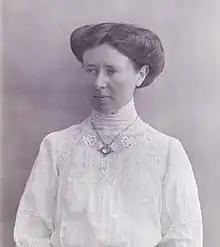Lillian Dove-Willcox
Lillian Dove-Willcox (1875 – 1963) was a British suffragette who was a member of Emmeline Pankhurst's personal bodyguard.
Lillian Dove-Willcox | |
|---|---|
 | |
| Born | 1875 Bedminster, England |
| Died | 1963 (aged 87–88) London, England |
| Nationality | United Kingdom |
Life
Dove-Willcox was born in Bedminster, Bristol in 1875. Her husband died in 1908. She was living in Bristol and attended the West of England branch of the WSPU.[1] The following year she was arrested at the House of Commons after trying to lobby on behalf of the Women's Social and Political Union[2] on 29 June 1909.[1]
She was sentenced to a month in Holloway Prison but she was released early after she went on hunger strike. She and Theresa Garnett were later convicted of assaulting a warder at Holloway. She again went on hunger strike to be released from a ten-day sentence.[1] She returned to Bristol where she, the future policewoman Mary Allen and Annie Kenney were met at the station and a procession of supporters welcomed them.[2]
.jpg.webp)
Dove-Wilcox was invited to Eagle House at Batheaston in Somerset in 1910. Eagle house was known as "Suffragette's Rest" because of its support for the movement. It was the home of fellow suffragettes Mary Blathwayt and her mother Emily. Emily had decided to plant a tree to commemorate every woman who went to prison for the cause. These trees came to be known as "Annie's Arboretum" after Annie Kenney who was local organiser. Dove-Wilcox planted a Picea Orientalis and a lead plaque was installed to record the event on 9 May 1910. Mary's father was a talented photographer and he recorded the event.[3]
Like the Blathwayts, Dove Wilcox offered lodging to suffragettes including the extreme Mary Richardson at her cottage in the Wye valley. Mary was devoted to Dove-Wilcox and wrote poetry about her love for her.[4] Dove-Wilcox took over from Annie Kenney as the leader of the WSPU branch in the West of England in 1911,[2] and expressed her loyalty to the Pankhursts by becoming a member of Emmeline Pankhurst's personal bodyguard. When Emmeline was arrested in Glasgow on 9 March 1913. She managed to travel back south on the same train as Emmeline and her guards. Two days later she was arrested at the Houses of Parliament and sentenced to another month in prison.[1]
Some members started to disagree with the WSPU. Emmeline and Christabel Pankhurst were demanding greater militancy and in 1913 the organisation and the Pankhurst family split over the issue of arson. Dove-Wilcox joined Sylvia Pankhurst and others who had created the socialist East London Federation of Suffragettes.[2]
She supported Edith How-Martyn in later documenting the movement in the Suffragette Fellowship.[5] Willcox died in Ealing in 1963.[1]
References
- Elizabeth Crawford (2001). The Women's Suffrage Movement: A Reference Guide, 1866-1928. Psychology Press. pp. 709–. ISBN 978-0-415-23926-4.
- "Lillian Dove Willcox". Spartacus Educational. Retrieved 4 April 2018.
- Taxus Baccata Elegantissima 1909, BathinTime.co.uk, Retrieved 30 October 2017
- "lillian dove-willcox | Woman and her Sphere". womanandhersphere.com. Retrieved 5 April 2018.
- "Museum of London | Free museum in London". collections.museumoflondon.org.uk. Retrieved 1 August 2019.